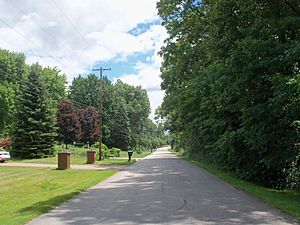Sugar Bush Knolls, Ohio facts for kids
Quick facts for kids
Sugar Bush Knolls, Ohio
|
|
|---|---|
|
Village
|
|

Lake Martin Drive, near the northern boundary of the village
|
|
| Country | United States |
| State | Ohio |
| County | Portage |
| Founded | 1964 |
| Area | |
| • Total | 0.25 sq mi (0.65 km2) |
| • Land | 0.23 sq mi (0.61 km2) |
| • Water | 0.02 sq mi (0.04 km2) |
| Elevation | 1,063 ft (324 m) |
| Population
(2020)
|
|
| • Total | 217 |
| • Density | 927.35/sq mi (357.33/km2) |
| Time zone | UTC-5 (Eastern (EST)) |
| • Summer (DST) | UTC-4 (EDT) |
| ZIP code |
44240
|
| Area code(s) | 330, 234 |
| FIPS code | 39-75196 |
| GNIS feature ID | 1086842 |
Sugar Bush Knolls is a small village located in western Portage County, Ohio, in the United States. In 2020, about 217 people lived there. It was created in 1964 from parts of two nearby areas, Streetsboro and Franklin townships.
This village is known for having the highest average household income in the Akron metropolitan area.
Contents
History of Sugar Bush Knolls
Sugar Bush Knolls has an interesting past. During the Great Depression, a company called Davey Tree operated a tree nursery here. They used the land to grow and experiment with different types of trees. The village got its name from the many sugar maple trees that grew near Lake Martin.
The Davey Tree Company owned the land where the village is now. They even kept horses in a barn on Ferguson Road. In the 1930s, the company let one of its employees, Charles Miller, and his family live in a small house there. At that time, the house had no electricity, phone, or even a well for water. The road was just gravel and didn't connect to Route 43.
Later, Martin Davey, who was the president of Davey Tree, arranged for three lakes to be dug out of the swampy land. These lakes were named Lake Martin (after him), Lake Roger, and Lake Quincy. Lake Roger was named after William Roger Williams, and Lake Quincy after David Quincy Grove, both important people at the Davey Tree Company. The area around the lakes was used by company employees for fun, with picnic spots and rowboats.
Martin Davey passed away in 1946, which stopped plans for building the company's main office there. In the 1950s, the land was divided into smaller pieces and sold for homes. A local business owner, Cyril Porthouse, bought many lots and built one of the first houses. He even loaned money to the village to help install sewers, which was important for developing the area. Some of the first families to build homes included the McElhones, Bushes, Longs, Kaisers, and Geldhofs.
There's a very unusual tradition in Sugar Bush Knolls: it's against the law to eat ice cream on Sundays! If you break this rule, you could get a $10 fine the first time. If you do it again, you could even spend three days in jail. This strange rule came from Martin Davey, who really disliked ice cream, especially on Sundays.
Geography of the Village
Sugar Bush Knolls is a small place. It covers about 0.23 square miles (0.60 square kilometers) in total. Most of this area, about 0.21 square miles (0.54 square kilometers), is land. The rest, about 0.02 square miles (0.05 square kilometers), is water, which includes the lakes.
Population Facts
The population of Sugar Bush Knolls has changed over the years. Here's how many people have lived there according to the U.S. Decennial Census:
| Historical population | |||
|---|---|---|---|
| Census | Pop. | %± | |
| 1970 | 119 | — | |
| 1980 | 201 | 68.9% | |
| 1990 | 211 | 5.0% | |
| 2000 | 227 | 7.6% | |
| 2010 | 177 | −22.0% | |
| 2020 | 217 | 22.6% | |
| U.S. Decennial Census | |||
2010 Census Details
In 2010, there were 177 people living in the village. These people lived in 69 households, and 52 of those were families. The village had about 843 people per square mile. There were 74 housing units, which are places where people can live.
Most of the people living in Sugar Bush Knolls in 2010 were White (91.5%). A small number were African American (1.1%), Native American (0.6%), or Asian (2.3%). Some people were from other backgrounds (1.1%) or a mix of two or more races (3.4%). About 2.3% of the population identified as Hispanic or Latino.
Out of the 69 households:
- About 26% had children under 18 living with them.
- Nearly 70% were married couples living together.
- A small number were single-parent households.
- About 16% of households had only one person living there.
- About 4% had someone aged 65 or older living alone.
The average household had about 2.57 people, and the average family had about 2.88 people. The average age of people in the village was 51.6 years old.
- About 17.5% of residents were under 18.
- About 5.1% were between 18 and 24.
- About 18.6% were between 25 and 44.
- About 39.1% were between 45 and 64.
- About 19.8% were 65 years old or older.
The village had slightly more females (52%) than males (48%).
See also
 In Spanish: Sugar Bush Knolls (Ohio) para niños
In Spanish: Sugar Bush Knolls (Ohio) para niños

